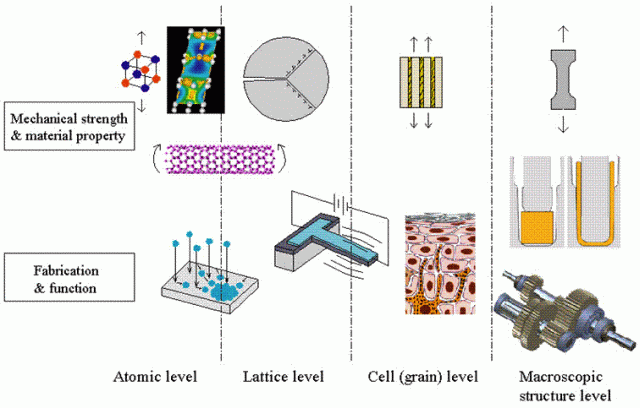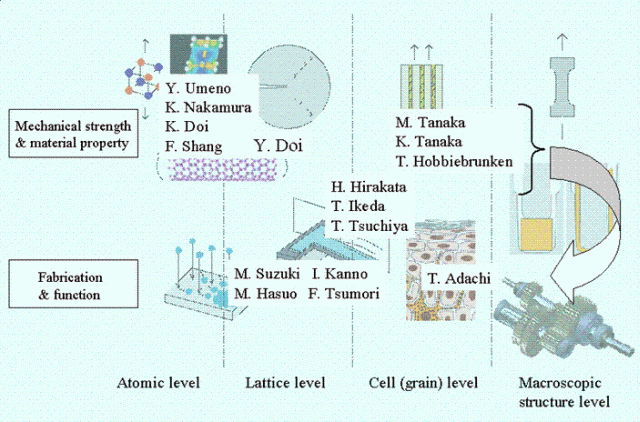
|

|

|

|

|

|
| Takayuki Kitamura |
| Materials Group Leader |
| Department of Mechanical Engineering and Science |
| Graduate School of Engineering |
From the viewpoint of conventional "complex science", the subject of our group may give a feeling that something does not in a place. Among four groups in the COE program, fewest research works have been done on the mechanical behavior of materials in terms of the conventional "complex science". However, the "modeling of materials" requires the concept of "complexity" because the rich behavior stems from its "compound understructure". In this program, we will discuss the modeling of materials on the basis of "complex science in a broad sense". We do not confine our activity in the conventional research subject on the materials behavior in the mechanical engineering in order to reconstruct the fundamentals for future development in the materials science.
The study targeted here is centered on the modeling of materials system (including behavior based on the quantum mechanics), which gives the fundamental idea on the design, production, service, and disposition (recycling) of "machine".
In this COE program, "the complex machine systems" are defined as:
In other words, "complexity" can be construed as various phenomena and structures that arise through interaction of numerous elements under an external environment. Generally, materials that constitute a machine have their own internal structures. Therefore, in the "complex science", material is regarded as a system made up with "elements forming an internal structure" and through "interaction of the elements".

Figure 1 shows research subjects on materials behavior in the mechanical engineering. The subjects are classified into 4 levels, (1) atomic, (2) lattice, (3) cell (grain), and (4) structure levels, according to the dimension of elements. While the basic behavior is illustrated in the upper column, the fabrication process and function of components are shown in the lower column. Although the focus is put on the mechanical strength in the conventional mechanical engineering, other physical properties (piezoelectric, magnetic, electric ones and so on) become important in the development of advanced machines and devices. Our group is investigating the multi-physical aspects of materials behavior. Since the variety of the behavior stems from the understructures, the material itself should be understood as a complex system consisted of multiple elements (microstructures). In view of the rapid progress in computers in recent years, fundamental knowledge obtained by experiments and analyses is integrated in the modeling of system, which gives us insight of not only scientific information but also wisdom for the design and control of industrial products.
As pointed out by the project leader, to comprehend the "complexity" consists of two processes, to identify the elements and to make clear their interaction. Focusing on the atomic level, the modeling and simulation based on the concept are briefly explained below.
At the atomic level, the element is an atom, and the interaction is governed by the quantum mechanics. The active research works are conducted on the low-dimensional nano-structured components such as nano-dot, nano-wire, and nano-film. The numerical simulation are conducted by the methods of molecular dynamics, molecular orbital, Metropolis (Monte Carlo) on the basis of the first principle. The large-scale simulation based on empirical interatomic potential is included in this level.
As the reader can understand from the example of atomic level, the key point in this project is to understand the complex substructure from the viewpoint of the elements and their interaction. This clearly contributes to enhance the multi-scale understanding of materials.
As mentioned above, a complex materials study has a wide range of themes. If all the themes are targeted in this program, it may cause desultory results. Therefore, considering the future of mechanical engineering and the past specialization areas of members in the group, the subjects are selected.

The major frontier in the mechanical engineering can be found in the nano- and micro-meter scales. In this program, therefore, we will focus on the research works at the atomic, and cell levels. Table 1 and Figure 2 summarize the young researchers selected and their subjects in 2003 fiscal year supported by the frontier research program. It clearly shows the key areas of this program. This year, we focus on:
Accordingly, in the entire program (five years), the main targets will be 1., 2. and 4. in the diagonal line from the upper left to the lower right of the figure. Every year the researchers and themes for the frontier research will be evaluated. Furthermore, as the program progresses, meetings to exchange information in the materials group are planned, and should develop joint research and cooperative relationships among researchers. Cooperation beyond fields and scales is expected e.g. piezoelectric materials -> Formation of thin film -> Structure -> Application to living organisms.
On the other hand, to strengthen cooperation with foreign researchers, exchanges (dispatch/ invitation) and joint research are planned.
| Researcher | Theme |
|---|---|
| Y. Umeno | Analysis on unstable deformation of solids by collective motion of atoms |
| M. Tanaka | Establishment of Complex System Simulation for Fracture Behavior of Fiber Reinforced Composite Materials |
| I. Kannno | Manipulation of droplets for molecular tapestry |
| M. Suzuki | Control of nano-morphology and mechanical properties of compound thin films using dynamic oblique deposition |
| K. Tanaka | Development of testing method for environmental mechanical properties of composite materials and evaluation of the localized environmental effects |
| M. Hasuo | Photo-induced changes of semiconductor thin films on TiO2 |
| F. Tsumori | Microstructure Design of Powder Particles under Magnetic Field with Discrete Element Method |
| H. Hirakata | Strength of microstructured small components |
| K. Nakamura | Analysis of Vibrational Behavior in Solid Materials by Perturbational Approach to Electronic Wave Function |
| K. Doi | Theoretical study on electronic states of bulk, surface, and interface under external fields in electronic devices |
| T. Hobbiebrunken | Mesoscopic Failure Prediction of Composite Materials A Multi-scale Analysis |
| F. Shang | Molecular Dynamics study on the internal stress problem of piezoelectric thin films |
| Y. Doi | The fracture of materials due to energy localization with lattice scale |
| T. Tsuchiya | Development of high-cycle fatigue tester and mechanical properties database for MEMS/NEMS materials |
| T. Adachi | Multi-scale modeling and simulation of bone regeneration/functional adaptation as a complex biological system |
Mechanical engineering has a long history and as the field can be regarded as a mature, but "machines" are transforming themselves day by day. Currently, machines (systems) that by definition didn't exist yesterday are being continuously produced. Materials constituting machines form the foundation of the present time and it is indispensable for a deep understanding of the complicated internal structures (systems) that materials themselves have in order to correspond to functional demand. The first-stage objective of this program is to grasp the nature and properties of materials that have internal structures by clarifying elements and their dynamical interaction. The second stage to develop a comprehensive and systematic understanding of "Mechanics of materials": Raw material => member => structure (physical properties -> function). One goal is to establish a common basis for dealing with "complexity" by reconsidering deformation/fracture and function from an atomic level and understanding the influence of inhomogeneity. The third stage is to develop fields in cooperation with other groups, while recognizing the internal structure of each field. We hope that this program will show a new direction for "Materials science in mechanical engineering".